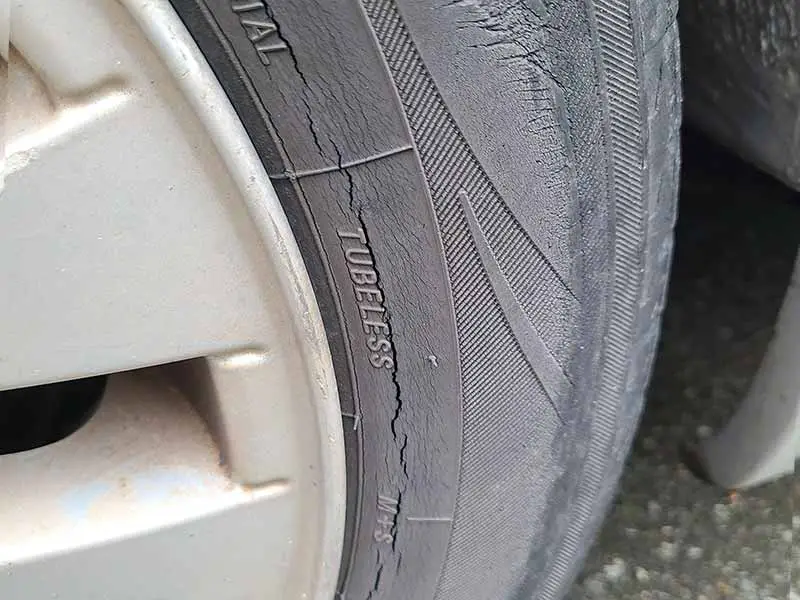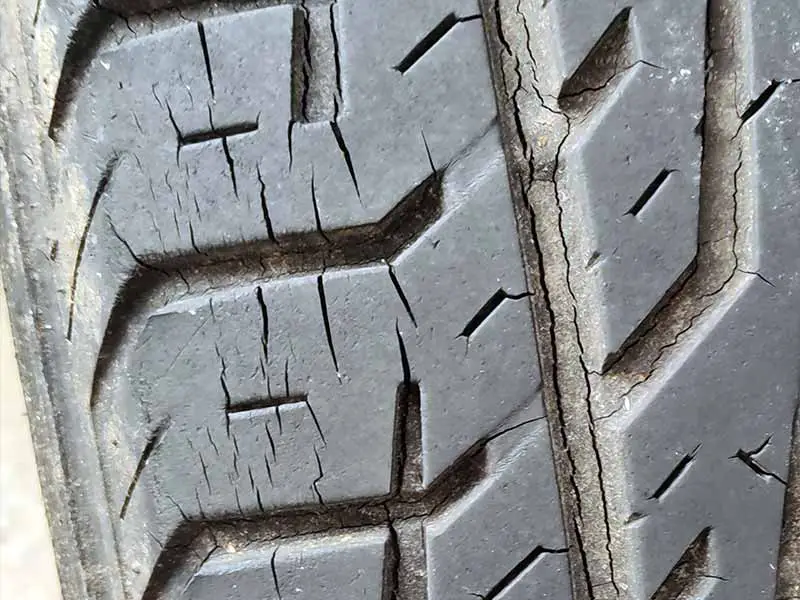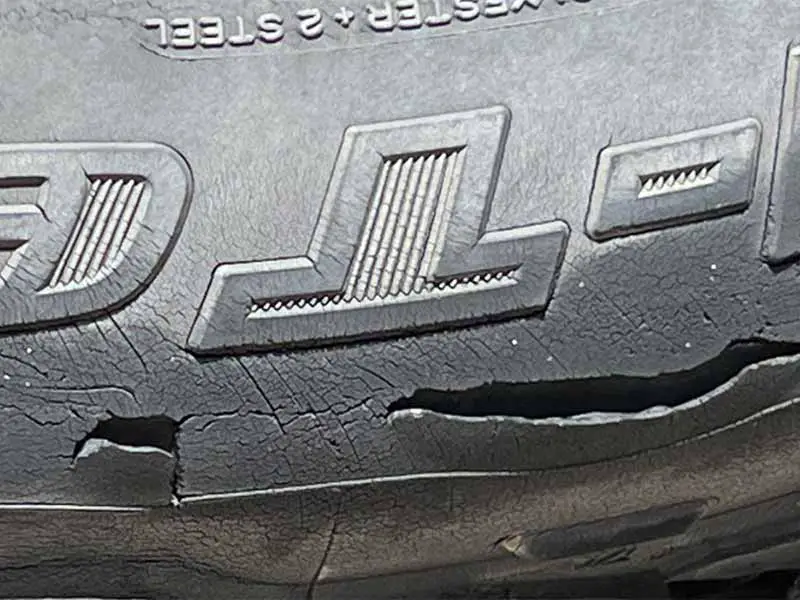Remember the last time you were getting ready for a long drive and noticed small cracks in the rubber of your tire? Did a feeling of uncertainty creep up, making you question whether it’s safe to hit the road? Tires are like the shoes of our vehicles and we want to ensure they’re always in top shape. But, are small cracks normal, or are they a silent cry for help? Let’s drive into this topic and uncover the truth.
Are Small Cracks In Tires Normal?
Small cracks in tires can be normal as they age and are exposed to various conditions. However, when these cracks widen and deepen to 1/16″ (2mm), they become a safety concern and should be replaced immediately.
In this article, we will delve into understanding the causes of tire cracking, the severity and implications of cracks in different parts of the tire, and when those cracked tires need to be replaced with a set of new tires.
Let’s take a closer look.

What Causes Cracks in Tires
Let’s dive into those thin, spiderweb-like lines that make you wonder, “Is this normal?” or “Should I be worried?” Well, let’s unravel this mystery together.
Tires Age, Just Like Us
First things first, every tire has a birth date. Yep, you heard that right. If you check the sidewall of your tire, you’ll find a four-digit number that represents the week and year it was made. And, like all of us, tires get older over time. This aging process can lead to cracks, especially if the tire rubber is exposed to harsh elements or isn’t taken care of properly. It’s like when our skin gets a bit wrinkly over time. It’s natural, but we can slow it down with a little TLC (Tire Loving Care).
The Sun – A Tire’s Frenemy
Ever heard of the saying, “Too much of anything is bad?” Well, the sun is one of those things for your tires. Direct sunlight can cause the tire’s rubber to dry out and eventually crack, a condition known as dry rot. It’s kind of like when your lips get chapped if you’re out in the sun too long without lip balm. So, it’s a good idea to park your car in the shade whenever possible or use tire protectant to block harmful UV rays.
The Pressure is On!
Tire pressure isn’t just about providing a smooth ride. It’s also about keeping your tires healthy. Both over-inflating and under-inflating your tires can lead to cracks. Over-inflation makes your tires more prone to damage from potholes or sharp objects on the road. Under-inflation, on the other hand, makes the tires work harder, generating more heat and speeding up the aging process. So, always make sure your tires are inflated to the right pressure – not too much, not too little.
When Neglecting Tires Comes Back to Haunt You
We get it, life gets busy and checking your tires might not be at the top of your to-do list. But neglecting your tires can lead to cracking. This can happen if your car sits unused for long periods or if the tires aren’t rotated regularly. It’s like not exercising for a while and then feeling a little stiff when you finally get moving.

Cracks in Different Parts of a Tire
Now that we’ve unraveled the mystery of why tires crack, let’s talk about where they crack. Yep, you guessed it, not all cracks are created equal. Some show up between the tread, others appear on the sidewall. So let’s break it down and see what’s what.
Hairline Cracks Between Tire Treads
Hairline cracks are usually thin and shallow. They often appear due to the natural aging process of the tire’s rubber, especially when it’s exposed to harsh conditions like extreme cold or heat. These types of cracks might look scary, but they’re usually not a huge cause for concern. However, don’t take them lightly. If they get deeper and wider, that’s when they could lead to problems.
Small Cracks on the Tire Sidewall
Now, let’s shift our gaze to the tire’s sidewall. That’s the area between the tire tread and the rim of the wheel. If you notice cracks here, it’s a bit of a different story.
These cracks can be due to a number of factors such as aging, exposure to sunlight, or even hitting a curb too hard (we’ve all done it). Unlike the hairline cracks between the tread, sidewall cracks are often a red flag. Why? Because the sidewall is crucial in supporting the weight of the vehicle and absorbing road shocks. Cracks here can compromise the tire’s structural integrity, which is definitely not what we want.
Understanding the Severity of Tire Cracks
Alright, the million-dollar question is, “How bad is it, really?” Are these small cracks just cosmetic, or are they a telltale sign that your tires are about to throw in the towel? Let’s dig a little deeper and see if we can find some answers.
When It’s Just Skin-Deep
Most tire manufacturers will tell you that minor, surface-level cracking is usually not a cause for immediate alarm. Think of it like those little lines we all get on our faces as we age—those charming little things we call wrinkles. They’re a sign that we’re getting older, sure, but they don’t mean we’re ready for retirement quite yet.
In the same way, small cracks on the tire’s surface can be a sign that the tire is aging, but as long as they are shallow and don’t penetrate too deep into the tire’s rubber, they’re often just cosmetic.
When to Start Worrying
Okay, but when do these cracks turn from a simple wrinkle to a full-blown issue? A general rule of thumb is, if the tire cracking is deeper than 1/16 of an inch it’s time to replace the tires.
Let’s say you notice a crack running along the tire’s sidewall. It starts off small, but over time it gets wider and deeper. Or, you find a hairline crack between the tread that’s grown deep enough to reach the base of the tread grooves. These are not just cosmetic issues anymore. It’s the tire’s way of telling you, “Hey, I might need some professional help.”
Driving on a severely cracked tire is like walking on thin ice—it could lead to tire failure, and that’s a risk you won’t want to take.
The Golden Rule: When in Doubt, Check It Out
If you’re ever unsure about whether a crack is only a cosmetic issue or something more serious, it’s always best to have your tires inspected by a professional. They’ll be able to give you the lowdown on what’s happening and whether your tire is still safe to use.
Resources
Below are some links you may find helpful when learning about tires
Final Thoughts
Navigating the world of tires might seem daunting, but the crux of it all is simpler than you think. Small cracks in tires can be a normal part of the aging process, especially when they are shallow and only affect the surface of the tire’s tread. However, when cracks become deeper, wider, or appear on the sidewall, they escalate from being merely cosmetic to a potential safety concern.
Maintaining your tires and regularly inspecting them for any signs of wear, cracking, or bulging is paramount to ensure your vehicle’s safety. Remember, your tires are more than just a part of your vehicle; they are your direct link to the road, playing a crucial role in handling, braking, and overall vehicle performance. If ever in doubt about the condition of your tires, seek professional advice. After all, when it comes to road safety, it’s always better to be safe than sorry.
Good luck and happy motoring.





